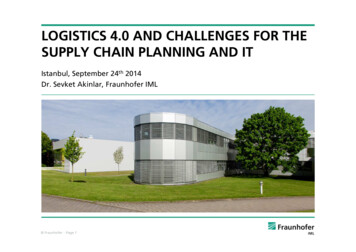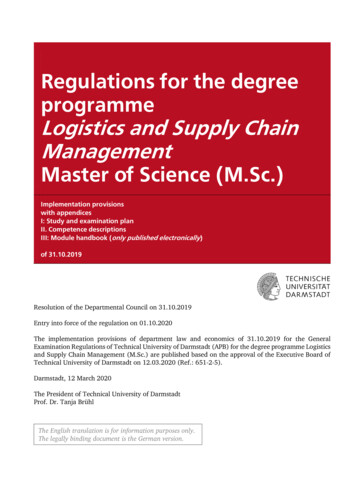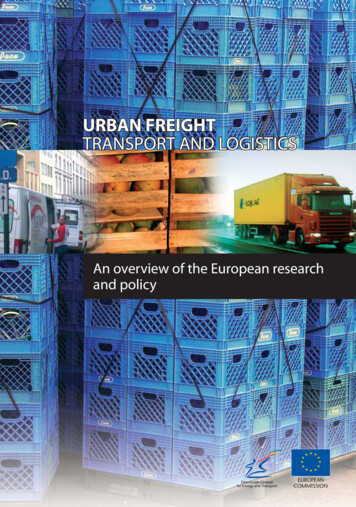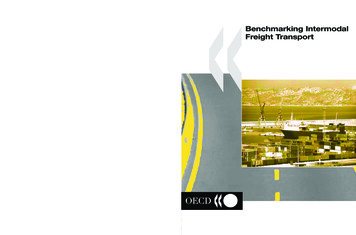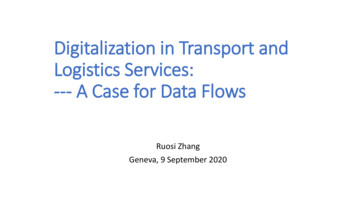
Transcription
Digitalization in Transport andLogistics Services:--- A Case for Data FlowsRuosi ZhangGeneva, 9 September 2020
Digitalization in Transport and LogisticsServices While transport services require physical delivery, digitalization istransforming the sector along the transport supply chain: Vehicle/ship design; Infrastructure: road, bridges, tunnels, rail, ports, terminals; Transport operation (e.g. capacity allocation, cargo management,shipment tracking and tracing, customer services, etc.) Intermediary services; Supporting services: warehousing, monitoring and inspection; Maintenance and repair of transport equipment; Information and documents transmission among multi-players(shippers, shipping lines, port authority, the Customs, terminaloperators, etc.)
Common features of digital trends Higher level of automation; Better and broader connectivity; Main digital technologies and solutions: Internet of Things, cloud computing, bigdata analytics, automation and robotics, artificial intelligence; Digital platforms become a new business model, which enable innovativetransport services or more efficient supply of services and increase tradability ofservices; Data-driven approach become dominant for both businesses and regulators; Digital synergies between transport/logistics services and other service sectors:digital transformation of transport and logistics services relies on the support ofother services, but also boosts the latter’s advances, such as: telecom, CRS,construction and engineering, energy, environment, and other business services.
Digitalization in road transport Higher levels of automation:platooning, autonomous vehicles Intelligent Transport System (ITS):wide deployment of road-side andin-vehicle sensors combined withBig Data analytics allows real-timeand fine-grained tracking so as toenable better management ofvehicles and loads. Digital freight brokerage services:Load-matching platforms, e.g. Uberfreight
Uber freight, a digital load-matching platformconnecting carriers and shippers
Digitalization inmaritime transport Online booking andonline cargomanagement Tracking and tracing ofshipments Routs optimization Autonomous vessels
TradeLens, a blockchain-enabled digital container logistics platform jointlylaunched by Maersk and IBM
Digitalization in railtransport Autonomous trains Signalling and trafficmanagement Digital train control Digital platforms forpredictive maintenanceand reparation E-ticketing
Digitalization in urban transport Digital technologies (e.g. AI, IoT, automation, Big Data Analytics, etc.)provides possibility to address chronical urban transport problems,e.g. traffic jams; lack of choice for consumers; inefficient utilization ofvehicles and space; pollution; etc.o Data collection and data analytics help better identify causes of problems andfind solutions;o Data-driven new public transport services: e.g. Via Van, US-German jointventure, on-demand, dynamic, data-driven public mobility – global reach,distinguished from ride-hailing and on-demand transit, relying on publicprivate partnership;o Digital platform enabled innovations, e.g. ride-hailing and car-sharing: Uber,Didi; bike/scooter sharing
Mobility as a Service (MaaS)
Digitalization in logistics services
Data at the centre of transport and logisticsservicesThe digitization of transport isAutomationin about creating newparadigms in the visualizationand capitalization of data, ofa given system and to usethat knowledge to build amore optimized andmaintainable infrastructures.”- McKinsey
Digital transformation in transport andlogistics: Policy implications Data is crucial not only for the operation of business, but also forgovernance and policy-making in the age of digitalization; Some other issues also become prominent: interoperability betweendifferent systems, harmonization of individual digitalization initiatives,standardization, safety, cybersecurity, etc. Synergies with other sectors require a holistic digital strategy to build asupportive ecosystem; Disruptive effects of digitalization on incumbent services and servicesuppliers require balancing policies and regulations; Policies and regulatory framework should foster innovations which are notonly sources of competitiveness, but also beneficial to public good.
THANK YOUruosi.zhang@wto.org
Digitalization in Transport and Logistics Services While transport services require physical delivery, digitalization is transforming the sector along the transport supply chain: Vehicle/ship design; Infrastructure: road, bridges, tunnels, rail, ports, terminals; Transport operation (e.g. capacity allocation, cargo management,

